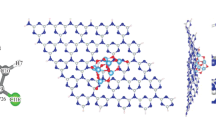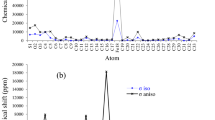Abstract
As a neurotoxic and corrosive gas pollutant, H2S is unhealthy for all creatures and limits the development of the industry. By first-principles calculation, the adsorption behaviors of H2S gas on the original graphdiyne (GDY), non-metallic atoms decorated GDY, and metal atoms decorated GDY were initially studied. The adsorption configuration, adsorption energy, and charge transfer between H2S and GDY were calculated in detail. The electron density and the partial density of states (PDOS) were also examined. The results show that there is only weak physical adsorption between the original GDY, non-metallic atoms decorated GDY, and H2S gas molecules, so GDY and non-metallic atoms decorated GDY cannot be directly used to adsorb H2S gas. The adsorption of H2S gas on GDY decorated with metal atoms (Cu, Ti, and V) was significantly enhanced, and the adsorption in this condition belongs to chemical adsorption. They can be used as H2S gas adsorbing materials. In addition, the dissociation of H2S on transition metal atoms decorated GDY was further investigated. The results show that H2S in one of the five configurations dissociates on V-decorated GDY directly. Cu- and Ti-decorated GDY can be used as substrates for the dissociation of H2S. The energy barriers in this process are 1.605 eV and 0.360 eV, respectively. It is hoped that the research results in this work can provide insights into the development of H2S gas adsorbing and dissociating materials based on transition metal atoms decorated GDY.






Similar content being viewed by others
Data availability
Not applicable.
Code availability
Not applicable.
References
Wylie S et al (2017) Materializing exposure: developing an indexical method to visualize health hazards related to fossil fuel extraction [J]. Engag Sci Technol Soc 3:426–463
Marutani E, Ichinose F (2020) Emerging pharmacological tools to control hydrogen sulfide signaling in critical illness [J]. Intensive Care Med Exp 8(1):5
Li F et al (2022) Rotten eggs revaluated: ionic liquids and deep eutectic solvents for removal and utilization of hydrogen sulfide [J]. Ind Eng Chem Res 61(7):2643–2671
Lambert TW et al (2006) Hydrogen sulfide (H2S) and sour gas effects on the eye. A historical perspective [J]. Sci Total Environ 367(1):1–22
Cai Q et al (2020) Oxygen defect boosted photocatalytic hydrogen evolution from hydrogen sulfide over active 0 0 1 facet in anatase TiO2 [J]. Appl Surf Sci 517:146198
Zhang Y-H et al (2013) Understanding dopant and defect effect on H2S sensing performances of graphene: a first-principles study [J]. Comput Mater Sci 69:222–228
Guo J et al (2007) Adsorption of hydrogen sulphide (H2S) by activated carbons derived from oil-palm shell [J]. Carbon 45(2):330–336
Li J et al (2021) Recent progress in two-dimensional materials for microwave absorption applications [J]. Chem Eng J 425:131558
Lv X-J et al (2022) Charge controlled capture/release of CH4 on Nb2CTx MXene: a first-principles calculation [J]. J Mol Graph Model 110:108056
Li D-L et al (2022) The adsorption behavior of H2S, SO2, CO, and O3 on non-noble metal doped BN: a theoretical study [J]. Surf Interfaces 30:101958
Sagynbaeva M et al (2015) Complementing the adsorption energies of CO2, H2S and NO2 to h-BN sheets by doping with carbon [J]. EPL 109(5):57008
Masoud DG et al (2012) Pt-decorated graphene as superior media for H2S adsorption: a first-principles study [J]. Appl Surf Sci 261:697–704
Reshak AH, Auluck S (2014) Adsorbing H2S onto a single graphene sheet: a possible gas sensor [J]. J Appl Phys 116(10):103702
Ibarra-Rodríguez M, Sánchez M (2020) Adsorption of H2, N2, CO, H2S, NH3, SO2 and CH4 on Li-functionalized graphitic carbon nitride investigated by density functional theory [J]. Bull Mater Sci 43(1):144
Imanzadeh G et al (2020) Adsorption behavior of H2S on P-doped, V/P, Nb/P, and Ta/P-codoped graphitic carbon nitride: a first-principles investigation [J]. Mater Chem Phys 252:123117
Wang F et al (2018) The role of electric field in enhancing separation of gas molecules (H2S, CO2, H2O) on VIB modified g-C3N4 (0 0 1) [J]. Appl Surf Sci 445:568–574
Naqvi SR et al (2020) Exploring two-dimensional M2NS2 (M = Ti, V) MXenes based gas sensors for air pollutants [J]. Appl Mater Today 19:100574
Khakbaz P et al (2019) Titanium carbide MXene as NH3 sensor: realistic first-principles study [J]. J Phys Chem C 123(49):29794–29803
Salami N (2022) First-principles realistic prediction of gas adsorption on two-dimensional vanadium carbide (MXene) [J]. Appl Surf Sci 581:152105
Xue Y et al (2018) 2D graphdiyne materials: challenges and opportunities in energy field [J]. Sci China Chem 61(7):765–786
Zheng E et al (2022) Insights into graphdiyne-supported single Ti for water dissociation reaction [J]. Comput Theor Chem 1207:113499
Nagarajan V, Chandiramouli R (2018) Investigation of NH3 adsorption behavior on graphdiyne nanosheet and nanotubes: a first-principles study [J]. J Mol Liq 249:24–32
Bhuvaneswari R et al (2020) Graphdiyne nanosheets as a sensing medium for formaldehyde and formic acid-a first-principles outlook [J]. Comput Theor Chem 1176:112751
Feng Z et al (2019) Oxygen molecule dissociation on heteroatom doped graphdiyne [J]. Appl Surf Sci 494:421–429
Ebadi M, Reisi-Vanani A (2021) Methanol and carbon monoxide sensing and capturing by pristine and Ca-decorated graphdiyne: a DFT-D2 study [J]. Physica E: Low-Dimens Syst Nanostruct 125:114425
Chen X et al (2017) High-efficient physical adsorption and detection of formaldehyde using Sc- and Ti-decorated graphdiyne [J]. Phys Lett A 381(9):879–885
He T et al (2019) Transition-metal single atoms anchored on graphdiyne as high-efficiency electrocatalysts for water splitting and oxygen reduction [J]. Small Methods 3(9):1800419
Liu X et al (2021) CO oxidation on Ni and Cu embedded graphdiyne as efficient noble metal-free catalysts: a first-principles density-functional theory investigation [J]. Appl Surf Sci 539:148287
Lin Z-Z (2016) Graphdiyne-supported single-atom Sc and Ti catalysts for high-efficient CO oxidation [J]. Carbon 108:343–350
Liu X et al (2020) Graphdiyne-supported single iron atom: a promising electrocatalyst for carbon dioxide electroreduction into methane and ethanol [J]. J Phys Chem C 124(6):3722–3730
Ye D et al (2014) Patterned graphene functionalization via mask-free scanning of micro-plasma jet under ambient condition [J]. Appl Phys Lett 104:103105
Zhang S et al (2021) Catalytic oxidation of CH4 into CH3OH using C24N24-supported single-atom catalyst [J]. J Mol Model 27:346
Lin C, Qin W, Dong C (2016) H2S adsorption and decomposition on the gradually reduced α-Fe2O3(001) surface: a DFT study [J]. Appl Surf Sci 387:720–731
Ling L et al (2013) DFT study on the sulfurization mechanism during the desulfurization of H2S on the ZnO desulfurizer [J]. Fuel Process Technol 106:222–230
Wang F et al (2016) Oxygen vacancies as active sites for H2S dissociation on the rutile TiO2 (110) surface: a first-principles study [J]. Phys Chem Chem Phys 18(9):6706–6712
Zhang H-P et al (2014) DFT study of adsorption and dissociation behavior of H2S on Fe-doped graphene [J]. Appl Surf Sci 317:511–516
Funding
This work was financially supported by the National Natural Science Foundation of China (52102017), Joint funds of Henan Provincial Science and Technology Research and Development plan (222301420038), the Henan Postdoctoral Foundation (2020SZZ02), and the Fundamental Research Funds for the Universities of Henan Province (NSFRF220410 and NSFRF220419).
Author information
Authors and Affiliations
Contributions
Yifei Wang: analyzed the data and wrote manuscript. Junkai Wang: calculation and developed the idea for the study and theoretical guidance. Tianqi Wang: drew a graphical abstract. Haixin Qi: writing — review and editing.
Corresponding author
Ethics declarations
Conflict of interest
The authors declare no competing interests.
Additional information
Publisher's note
Springer Nature remains neutral with regard to jurisdictional claims in published maps and institutional affiliations.
Rights and permissions
Springer Nature or its licensor (e.g. a society or other partner) holds exclusive rights to this article under a publishing agreement with the author(s) or other rightsholder(s); author self-archiving of the accepted manuscript version of this article is solely governed by the terms of such publishing agreement and applicable law.
About this article
Cite this article
Wang, Y., Wang, J., Wang, T. et al. The adsorption and dissociation of hydrogen sulfide on transition metal atoms decorated graphdiyne: a first-principles calculation. J Mol Model 28, 384 (2022). https://doi.org/10.1007/s00894-022-05375-6
Received:
Accepted:
Published:
DOI: https://doi.org/10.1007/s00894-022-05375-6




